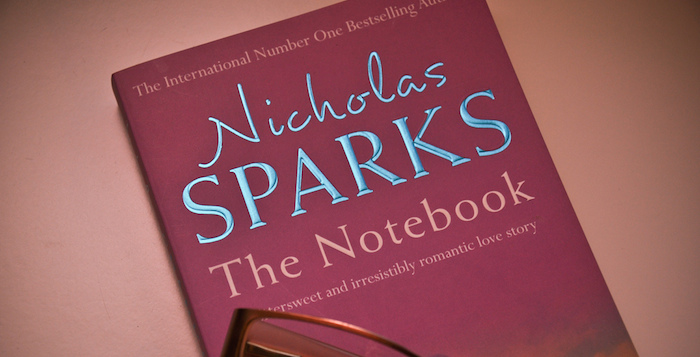So run the famous lines from The Notebook, Nicholas Sparks’ popular romance novel that made it to the big screen: “They didn’t agree on much. In fact, they didn’t agree on anything. They fought all the time and challenged each other every day. But despite their differences, they had one important thing in common. They were crazy about each other.”
Absolutely sigh-worthy, though we may be sighing for different reasons. It’s a familiar tale — not only to Sparks’ enthusiasts, but to anyone who has seen a Hollywood romance in his or her day. I’ve never been in a serious relationship, but I’ve seen enough of them to know that what Sparks writes are not “romance novels” — they’re fairy tales, pure and simple.
So why don’t we treat them like fairy tales?
Reality check: Sparks is filing for a divorce, citing “irreconcilable differences.” He was married for 25 years. He reified Hollywood’s notion of romance in popular culture. Look up “romance” in the dictionary, and you can expect his picture pasted in by one of his fans. Judging by his books, if he can’t make a romance work, no one can.
According to Twitter user @LANDOW747: “Nicholas Sparks getting a divorce could be equated to your rehab physician doing cocaine.”
But it was Sparks himself who told us to judge by actions, not words: “You’re going to come across people in your life who will say all the right words at all the right times,” he wrote in The Rescue, “But in the end, it’s always their actions you should judge them by. It’s actions, not words, that matter.”
So, let’s judge him, and let’s judge the flowery romantic nonsense he passes as literature, by his actions: he is getting divorced. As the blogger Matt Walsh has pointed out, Sparks suffers from a disease, a disease infecting millions of our nation’s men and women: fantastical and unrealistic perceptions of romance. He has some highly problematic notions about romance, which he propounds in his novels. And what’s more? He’s contagious.
Ultimately, Sparks’ ideology is not merely mistaken; it’s hideously and insidiously misleading, and his novels and notions do an immeasurable amount of harm to our culture. Readers and viewers who do not understand the limitations of fictitious romance as a predictor for real-world romance will find themselves expecting Sparks’ characters to walk off the page and into their lives.
But in the real world, the one you and I inhabit, meeting Noah Calhoun from The Notebook wouldn’t be a heart-melting experience.
Let’s think about it. This guy jumps onto a Ferris wheel seat between some girl he’s never met and an equally strange guy, insistently asking the girl out. Then he hangs from said Ferris wheel, threatening to let go unless said-girl-he’d-never-even-met went out with him. (“I was drawn to you” is his excuse.) When she gives in and they go out, he lies down in the middle of the road, which is somehow supposed to be romantic. “Trust me,” he says, telling her to lie down next to him; they almost get run over. Still catching his breath, he asks her to dance on the same road. Seriously.
Calhoun meets all the criteria of a psychopath. But this dark stranger from the other side of the tracks, this mythological, rough and rugged character so adored by women in popular media (think Christian Grey from Fifty Shades of Grey), “probably has herpes, a coke habit and a criminal record,” as Walsh puts it. And yet Calhoun and characters like him continue to establish our society’s romantic standards.
Over Thanksgiving I watched the movie The Fault in Our Stars (different author, same problems) with some friends. Let me ask you: if someone you had never met just stared at you during a cancer support group, smiling knowingly when you looked his way, would you really find that flattering and attractive?
It’s just creepy. But when I objected, I was told you can pull it off in real life, but only “if you’re cute enough.” Later on in the movie, Gus Walker tells the girl, “All your efforts to keep me away from you are going to fail.” Let me just say that there is a good reason people carry pepper spray.
Still, it wouldn’t be fair to say that characters like Calhoun and Walker are all creep and no charm. There are the romantic picnics, witty and endearing remarks and those bedazzling good looks. But all these only compound the problem.
Love isn’t always flaming affection, scenic picnics and passionate physical intimacy …
We can’t forget that after everything, this is a world of narrative; someone makes a living spending countless hours crafting a minute-long scene. That’s why everything will always be “perfect.”
But real life just isn’t like that, and it’s incredibly damaging to hold on to these ideals as a real-world standard. We find ourselves longing for and expecting something that sounds good on paper or on-screen, but these same ideas are what we actually find disturbing or weird in real life. Or we long for and expect a romance so “perfect” that could only ever exist on paper or on-screen. Like pornography, it sets unrealistic and unachievable standards that leave a second party inadequate, powerless to satiate. It’s a lose-lose situation.
Although paperbacks and “chick-flicks” are more than capable of ruining a generation of lovers, an increasingly media-saturated and social network-validated culture has exacerbated the problem. Through technology, we have gained the ability to isolate ourselves, displaying selected pieces of our lives in the form of selfies, status updates, etc. Of course, we only show the best parts, the highlights and even those we like to embellish (hence the numerous photo filters on your phone). But who do you know who has tweeted their divorce filings? When has your Instagram feed featured pictures of tears, smeared makeup and disheveled hair, with the caption “first fight! :)”?
We extrapolate an image of what romance is “supposed” to look like from Sparks and social media. But of course, such a detached view of life will be idyllic; everything looks good from far away, as the saying goes. But life is not a Monet painting.
Instead, we are forced to take a closer look every day, and our noses are shoved into its unpleasantries. It’s the same with romance: we are pressed to see the ugliness, the dark recesses of our loved ones, and then we continue loving them.
As most people have experienced, love involves a lot of mundanity. Love isn’t always flaming affection, scenic picnics and passionate physical intimacy; nor is it always rainbows and butterflies. In fact, it often looks a lot like a friendship. Real love — not the stuff Sparks propounds — integrates the mundane, the everyday, the chores and the obligations, the sacrifices and concessions — everything that Sparks will avoid if he wants to continue making money. It takes all these things and it redeems them, giving them a new meaning, a new beauty.
This is precisely the love we find in the Gospels, the Romance of all time. John’s Gospel tells us that, “No greater love has anyone than this: that he would lay down his life for his friend.” Paul finishes the thought in his letters: “Very rarely will anyone die for a righteous person … but God demonstrates his own love for us in this: While we were still sinners, Christ died for us.”
Jesus’ selfless death and his reckless pursuit of a broken humanity exemplify the kind of love modern relationships could truly benefit from. Jesus didn’t send us sappy love letters; he took on flesh and spoke face-to-face, and he said some pretty harsh things — because he loved us.
Likewise, Jesus didn’t wine and dine us with romantic picnics, but he gave us his very flesh and blood. Jesus didn’t have butterflies in his stomach when he dragged his cross to Calvary. Nor did he endure that cross because he had some kind of vague, fuzzy feeling for us. Rather, Jesus let himself be murdered because he loved us, with a love so selfless and flawless that we can’t even comprehend what or why it is.
Let’s forget everything Sparks has taught us about romance; that stuff only ends in divorce. (According to the American Psychological Association, the U.S. divorce rate is 40 to 50 percent). It’s time to examine the gaps in our News Feed, to ask ourselves what the Instagram photo looks like without that snazzy color saturation. It’s time to ask our parents, grandparents and friends what their romance looked like — and what it looks like 10, 20 and 50 years later. It’s time to understand that love, real love, is gritty. It involves pushing past “irreconcilable differences”; it takes persistence, hard work and the forgiveness of faults.
Love doesn’t just form magically overnight, lasting forever or until cancer or Alzheimer’s strikes. Let’s escape the lies of Sparks and social media, and the expectations those lies lead to. Not only is it unfair for others, who can never fulfill our expectations, but it is ultimately unfair to us, who can never have our expectations fulfilled.
Jon Warkentine is a College junior from Almaty, Kazakhstan.
The Emory Wheel was founded in 1919 and is currently the only independent, student-run newspaper of Emory University. The Wheel publishes weekly on Wednesdays during the academic year, except during University holidays and scheduled publication intermissions.
The Wheel is financially and editorially independent from the University. All of its content is generated by the Wheel’s more than 100 student staff members and contributing writers, and its printing costs are covered by profits from self-generated advertising sales.






